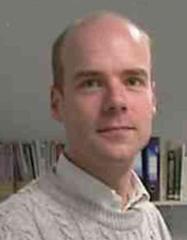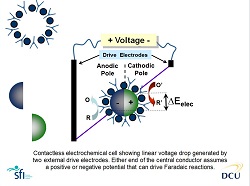Distinguished iNANO Lecture: Electrochemistry without wires: From on demand drug delivery to fuels from wind energy
Professor Robert J. Forster, National Centre for Sensor Research School of Chemical Sciences, Dublin City University, Dublin, Ireland
Info about event
Time
Location
iNANO Auditorium (1593-012), Gustav Wieds Vej 14, 8000 Aarhus C

Professor Robert J. Forster, National Centre for Sensor Research School of Chemical Sciences, Dublin City University, Dublin, Ireland
Electrochemistry without wires: From on demand drug delivery to fuels from wind energy
Electrochemistry represents a powerful approach for controlling the energetics, and hence the rates, of electron transfer. By doing so, it can contribute to solutions to global challenges from health to climate change mitigation. However, one of the key disadvantages of electrochemistry over optical methods is the need to connect the electrodes to an external potentiostat using wires. Our goal is to develop bipolar or “wireless” electrochemistry to eliminate the need for these wires. For example, Figure 1 shows that when an electronically conducting, drug loaded CAPTIVATE nanoparticle, is placed between a pair of external “drive” electrodes, that are not in electrical contact with the particle, an electric field is generated that induces positive and negative potentials at either side of the particle, i.e., it becomes a bipolar electrode.
| Figure 1. Wireless electrochemical cell showing linear voltage drop generated by two external, electrically isolated, drive electrodes. Either side of the conducting particle assumes a positive or negative potential that can change the redox composition of the particle releasing the drug. |  |
By tuning the voltages applied to the drive electrodes, potentials capable of oxidising the conducting polymer can be generated triggering drug release. We are developing this wireless electrochemical drug release strategy and significant new innovations such as nanoparticle self-assembly around cancer cells to allow drugs to be released using weak, biocompatible electric fields. A key novelty is that the drug delivery system is double locked in that drug will only be released at sites where both the particles and electric field are present. As illustrated in Figure 2, the second part of the talk focuses on the highly sensitive detection of disease biomarkers using wireless electrochemiluminescence. Our objective is to couple this analysis of a patient’s blood sample with the triggered drug release to achieve closed loop control.
 |
|---|
| Figure 2. Ultrasensitive, digital assay for the detection of drug efficacy biomarkers. miRNA biomarkers are illustrated but the strategy also applies to capture antibody-protein target assays. |
Finally, the application of wireless electrochemistry for the electrocatalytic reduction of carbon dioxide, the production of fuels, e.g., hydrogen peroxide, or the destruction of recalcitrant organics in wastewater, using metal and conducting diamond particles is considered.
Host: Associate professor Elena Ferapontova, Interdisciplinary Nanoscience Center, Aarhus University
Coffee, tea and buns will be served from 10:00 in front of the auditorium
